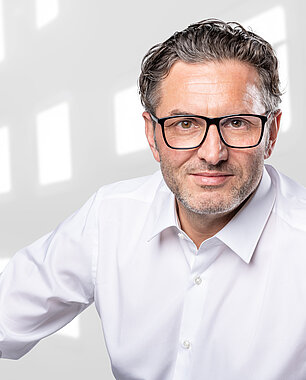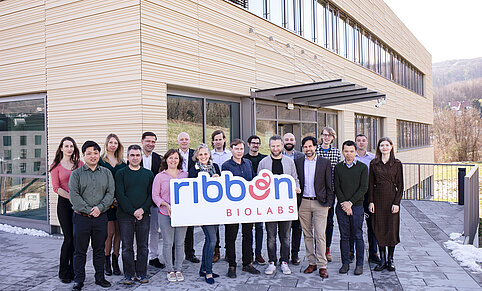 © Durst Phototechnik AG
© Durst Phototechnik AG
- Success story
- Research & development
Durst – Why (Tyrolean) stubbornness can be a major locational advantage
19. September 2022In addition to the good planability and the manageable burdens imposed upon companies, Austria’s functioning social partnership as a balancing force and the good cooperation with ÖKB Export Services comprise a unique selling proposition for the Austrian business location, says Christoph Gamper, CEO of the Durst Group. Christoph Gamer also considers the “Tyrolean stubbornness” to be an important and highly valued quality, above all in East and South Tyrol. This is particularly the case when it comes to mechanical engineering, innovation and inventiveness.
Interview with Christoph Gamper, CEO Durst Group, and Harald Oberrauch, President Durst Group
Durst Austria in Lienz represents a strong and extremely successful presence of the Durst Group. In turn, this does credit to the Austrian business location. How important is the Lienz facility for Durst?
CG: It is very important! As an integrated service provider for digital printing facilities, we offer much more in Lienz than just pure mechanical engineering. Over the past eight years the Lienz site has also emerged as our main development centre for one of the most important areas in the company, namely software development - in other words everything that happens relating to the machinery.
What do you consider to be the strengths of the business location of Austria for your type of company, and which general conditions in Austria are particularly crucial for Durst’s success?
CG: On the one hand, there is the good educational level of the people as well as their strong motivation and attitude. The high standing of the company in the population is something which is extraordinary for us. We are seen overall as a driving force and not as a burden. This is extremely important for us and also one of the reasons why we view Lienz as a very strong location. The affinity and proximity to similarly oriented companies and the possibility to interact with them is also advantageous to us. In other words, we operate in a fertile environment all in all.
In your opinion, is there a unique selling proposition i.e., an advantage for companies which only Austria offers?
CG: I would consider the cooperation of the social partners in Austria to be close to a USP. A very balanced mix exists in Austria, and it really works very well. The burdens imposed upon companies in Austria are bearable.
HO: Moreover, we closely cooperate with ÖKB Export Services of Austria’s Kontrollbank, the export credit agency, which is very important for us. Taken together these two features definitely comprise a unique selling proposition for us. With the exception of the coronavirus and the Ukraine war, planability in Austria is also very good. This is naturally of enormous importance for a company. (Of course, what is unfortunately less favourable about the Lienz location is its limited accessibility. For this reason, we have not entered into any extensive partnerships with universities because the distances are unfortunately frequently too long.)
Austria stands out thanks to a high research ratio, funding and incentives such as the research tax credit as well as the outstanding networking between business and science. To what extent has Durst and its Research Centre for Inkjet Technology based in Austria been able to benefit from these features?
CG: Naturally, as a company we are also involved in research and development and have an average research ratio p.a. of 7-12% of our net revenue depending on the area and year. We are currently carrying out somewhat less R&D in Austria at present due to the restructuring of the Group, but this can change at any time. The cooperation with the Austrian Research Promotion Agency FFG has always functioned perfectly for us. We also benefited from the research premium for several years. In general, we have taken advantage of many incentives offered by the business location in the past. It has all been very unbureaucratic, in turn helping us to develop innovations. We have expanded from our initial workforce of 24 people to the present level of 250 employees. This would not have been possible without public sector assistance.
Your site in Lienz in East Tyrol is also home to the flatbed and packaging printing production of the Durst Group. How would you rate the quality and motivation of the Austrian employee in an international comparison and how important are these attributes for the success of your company?
CG: We measure our employee satisfaction every year. 95% of our employee agree with the statement that Durst “is an outstanding company”. The employees in Lienz stay with us for quite a long time and there are really only a few who end up leaving. I would also like to highlight the positive “Tyrolean stubbornness” as an advantage. In the mountains you won’t find everything everywhere, and not everything is available nearby as it is elsewhere. In this region it is vital to be a bit more obstinate than in other places in order to achieve one’s goal. This is an incredibly important trait which we highly value, particularly with respect to mechanical engineering, innovation and inventiveness. It is something we see especially in East and South Tyrol. This is very important for us in an international comparison and also a key to our success. The Tyroleans are top class in the high-end digital segment.
Why did Durst originally decide in favour of Austria in its international expansion and why have you remained loyal to the business location (for so long)?
CG: Generally speaking, the similar mindset I previously talked about is one factor. We carry out extensive research and development work. We require creative minds and inventors, and we also need stubbornness. Geographical proximity was also another factor in our decision. Austria plays a key role for us. Business strategies can tend to be quickly absorbed by the culture, and this is certainly not the case in Lienz. For example, we manage hard times more easily together than if you operate a subsidiary in Shanghai - a place which was not accessible for two years. This represents a major locational advantage for us. For this reason, we also decided to stay in close geographical proximity to our headquarters.
Were there any particularly formative or significant events, turning points or personal experience in the corporate history of the Austrian facility which you vividly remember?
CG: One personal experience which took place more than ten years ago was quite profound for me. As the designated CEO I had just joined the company and went to Austria for my first Christmas celebration. One of the employees came up to me. I had just arrived from the USA after being posted throughout the world for 15 years. The employee said, “Hey you, are you the new boss? The first thing is that we must have a drink together.” And this represented the beginning of our using the familiar German word “du” in the company for “you” instead of the more formal “Sie”. And for me this introduction was a very pleasant and positive experience which symbolised my being welcomed as the new CEO of the Durst Group.
HO: We continuously communicate at eye level with our employees, and this a good thing. In fact, the employees themselves demand this. Criticism and suggestions for improvement are welcome and can also be transparently discussed and communicated. We have something resembling a good conflict culture in a positive sense.
From your point of view, what is it about the Austrian business location which has changed over the years and decades? What has improved and what was better in the past?
CG: From my point of view and my own experience, the business location has developed well. The bureaucracy has become more efficient, we have direct access to public authorities, and everything is less complicated, particularly due to digitalisation and also thanks to our very strong business association. In other words, I feel that the overall situation has improved.
HO: The business association does quite a lot for us, and it is even more focused today on companies than in the past. It provides information and assistance which is very important for us.
Could you briefly outline the most important milestones with regard to Durst’s activities in Austria?
CG: There is actually a long list of milestones. But in particular, it is important to mention that Lienz has established itself in the field of board printing and has developed unique solutions in digital packaging. One real milestone was the joint venture with König &Bauer, one of the largest producers of printing machines in the world. It is a 50-50 partnership in the digital segment focusing on offering corrugated cardboard solutions, i.e., for external packaging. We do it digitally, with water technologies, in an ecologically sound and sustainable manner and on demand. This joint venture and the founding of the software company PPD (PrePress Digital) at the Lienz site were the most important milestones. Both took place over the last eight years. Everything we did before that led to these events.
What are the next steps which Durst plans for Austria? Can you already tell us anything about this today?
CG: We want to expand our centre for digital packaging printing and the software company on site in Lienz. Both are growing and fortunately the entire business is expanding once again after the coronavirus pandemic. We also have our centre for digital textile printing in Kufstein in Tyrol and we are going to also take a closer look at this.
We would like to double the entire group again by 2025/2026. This is something we already succeeded in doing over the last eight years. Austria plays a major role in our strategic thinking.
We are continuously on the lookout for acquisitions. We want to be number two in the world for packaging printing, one of the biggest growth areas for digital sustainability. Our efforts will also lead to some growth at the Lienz facility.
HO: We basically simply want to grow on the basis of the existing strategy, become even better and expand our operations. We want to strengthen the facility because we believe in this site. There will also be a moderate expansion of our manpower and womanpower.
Do you have any wishes with respect to the Austrian business location or Austrian Business Agency?
CG: Yes. I do in fact have some wishes relating to the Austrian business location. We would like more direct support and pragmatism with respect to energy policies - which is an existential question for a company. It seems that the issue of energy has not been treated recently with the necessary seriousness. Little has come in the way of tangible results. This failure could also lead us to reduce our presence at the site. (Italy is several steps ahead. South Tyrol has the Communità Energetica, which makes it possible to expand a consolidated energy system for the site.) If electricity costs are suddenly 800% higher, this is no longer a calculable factor and represents a competitive disadvantage of the location. I see a need for action on the part of political decision makers. If the underlying conditions for a company change so drastically and inexplicably - and considering that hydropower accounts for 90% of energy consumption in Tyrol - then our facility will have to reconsider the situation. This could happen if we end up with a lot less in our pockets.
How did Austrian Business Agency help Durst in setting up its subsidiary in Austria and afterwards?
HO: They took the lead in our business location project - and I would like to really mention Maurizio Bossi-Fedrigotti in memoriam. He supported us with a great deal of commitment, motivation and a high level of professionalism. Hats off to him! If one has such people as employees, then you have already one big advantage. He really personally moved the project forward.
And finally, one last question: what do you personally value the most about Austria?
CG: I value the handshake quality with the country and the people. This is difficult to find, not only among individuals but really also with respect to the country itself. Naturally the countryside and mountains are magnificent.
HO: I would give the same answer. However, I would like to add the stubbornness of the people in Tyrol, their precision and the motivation to drive things forward until perfection is achieved.
Durst Phototechnik AG
As the leading manufacturer of pioneering digital production technologies boasting a global workforce of about 1,000 employees, the Durst Group headquartered in Brixen, Italy has been successfully operating in Austria for about 25 years through its subsidiary Durst Austria GmbH in Lienz, East Tyrol. The Eastern Tyrolean location of the Durst Group expanded from an initial workforce of 24 employee at the outset to 250 at present and has positioned itself in the field of board printing thanks to its unique solutions in digital packaging. The Lienz site is home to the research centre for inkjet technologies as well as production operations for flatbed and packaging printing.
More Success Stories



